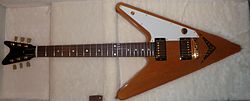Flying V
 |
|
| Manufacturer | Gibson |
|---|---|
| Period | 1958–1959, 1963, 1967–present |
| Body type | Solid |
| Neck joint | Set-in |
| Scale | 24.75 in (629 mm) |
| Body | Korina, mahogany |
| Neck | Korina, mahogany |
| Fretboard | Rosewood, ebony, baked maple |
| Bridge | Tune-o-matic, and "Short Lyre Vibrola" used on some models |
| Pickup(s) | H-H: 496R (neck), 500T (bridge) |
| "Classic White", cherry, ebony, natural | |
 |
|
| Manufacturer | Gibson |
|---|---|
| Period | 1979–1982 |
| Body type | Solid |
| Neck joint | Set-in |
| Body | Walnut/Maple |
| Neck | Walnut/Maple, with brass nut |
| Fretboard | Ebony |
| Bridge | Tune-o-matic |
| Pickup(s) | H-H: 1979–81 Boomerang(neck & Bridge), 1982 Dirty Fingers(neck & bridge) |
| Natural initially, then custom colors: Pearl white, Blue sparkle, Blue sparkle metallic, Candy apple Red, Goldburst, Silverburst, Sunburst, Black and Black Sparkle. Candy Apple Red and White Finishes only for 1982 Dirty Finger models. | |
 |
|
| Manufacturer | Gibson |
|---|---|
| Period | 2007–2008 |
| Body type | Solid |
| Neck joint | Set-in |
| Body | Mahogany |
| Neck | Mahogany |
| Fretboard | Rosewood (2007), ebony (2008) |
| Bridge | Tune-o-matic |
| Pickup(s) | H-H: '57 Classic (neck), '57 Classic (bridge) |
| 1st release: Trans Amber. 2nd release: Natural. Classic White, Ebony Black | |
The Gibson Flying V is an electric guitar model first released by Gibson in 1958. The Flying V offered a radical, "futuristic" body design, much like its siblings: the Explorer, which was released the same year and the Moderne, which was designed in 1957 but not released until 1982.
Gibson first manufactured prototypes of the guitar in 1957. Production guitars were made of korina wood, a trademarked name for limba, a wood similar to but lighter in color than mahogany. This Flying V, along with the Futura (Explorer) and, initially, the Moderne, made up a line of modernist guitars designed by Gibson's then-president Ted McCarty. These designs were meant to add a more futuristic aspect to Gibson's image, but they did not sell well. After the initial launch in 1958, the line was discontinued by 1959. Some instruments were assembled from leftover parts and shipped in 1963, with nickel- rather than gold-plated hardware.
McCarty started out with a mahogany guitar that was rounded in the back instead of being cut out. Gibson decided to change the back for weight reduction.
Blues-rock guitarist Lonnie Mack and blues guitarist Albert King started using the guitar almost immediately. Mack used his 1958 Flying V almost exclusively during his career. King used his original 1958 instrument into the mid-70s and later replaced it with various custom Flying Vs. Later, in the mid-late 1960s, such guitarists as Dave Davies, in search of a distinctive looking guitar with a powerful sound, also started using Flying Vs. The renewed interest created a demand for Gibson to reissue the model.
Gibson reissued the guitar in mahogany in 1967, updating its design with a bigger pickguard, and replacing the original bridge, which had the strings inserted through the back, with the stopbar tail piece more commonly associated with Gibson models. Some models were shipped with a short Vibrola Maestro Tremolo. This 1967 model is now the standard for the Flying V although the earlier design is periodically reissued. Like other Gibson guitars the Flying V's is angled at 17 degrees to increase string pressure on the nut to increase the amount of sustain. The design of the V places the pickups near the center of mass of the entire guitar, further enhancing sustain.
...
Wikipedia
